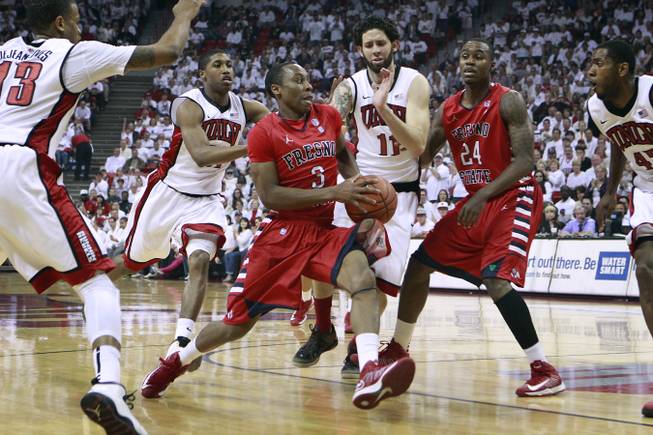
Sam Morris / Las Vegas Sun
Fresno State’s Kevin Olekaibe drives to the basket against UNLV during their Mountain West Conference game March 9, 2013 at the Thomas & Mack Center.
Wednesday, June 12, 2013 | 2 a.m.
On the surface, the NCAA’s hardship waiver was created for a student-athlete just like Kevin Olekaibe, the former Fresno State junior whose father is in Las Vegas hospice care after multiple strokes have left him unable to speak and paralyzed below the waist. Olekaibe, a Cimarron-Memorial High School grad, informed the Bulldogs he’d be leaving in April and recently started taking classes at UNLV though he's not yet fully enrolled.
Related Coverage
While most players would have to sit out a season — two seasons in this case, since it’s a move within the same conference — Olekaibe’s situation seems to be a prime example of why this waiver exists. However, this is the NCAA, and there’s no guarantee things will be that simple.
Any student-athlete transferring from one school to another can apply for the waiver, which, if granted, absolves players of the mandatory year or two away from athletics because their decision isn’t about something like playing time. The NCAA’s website states the guideline for approval in a family case is for a player who “wants to return to a school closer to home due to the illness or injury of an immediate family member (the student-athlete's mother, father, sibling, child or legal guardian).”
That certainly applies in this circumstance. Olekaibe’s father, Benson, suffered his first stroke in 2008 but a second one more recently has made things worse.
“I don’t remember the last words he said to me,” Olekaibe told the Sun on Monday. “His left side in unresponsive. He doesn’t speak. He always told me family comes first, so coming home was an easy decision.”
Olekaibe asked for his release from Fresno State in April without getting into too many details about his father's health issues. The university initially balked at the idea of him going home and playing for a conference foe, so he then had to present his case to a two-person panel, which included a Fresno State professor and a person Olekaibe couldn't remember, who granted his release last week.
Olekaibe has a tight-knit family with six siblings, including two older brothers who also played college basketball. His mother, Esther, is thrilled to have him home, he said. And he's thrilled to be back, where he thinks the mental struggle of being away from his family during such a trying time may be lifted at least a little.
The other thing Olekaibe has in his favor with the waiver is that even though the Rebels have an open scholarship, he’s not using it. Everything suggests this is a family decision that he would like to also involve one more year of basketball.
However, since basically any transferring student-athlete can apply for the waiver and few players want to miss a season, the system is often manipulated. Last summer ESPN reported that from April 2007-April 2012 the NCAA has approved approximately half of the total undergraduate hardship waivers filed in all sports (631) during that time. In basketball, the ledger was even: 47 approved, 47 denied.
That number is for all hardship waivers, including those requesting them for financial or injury reasons. The NCAA doesn’t compile figures specifically for those who say they’re moving in order to be closer to an ill family member. Hardship waivers also include situations like Mike Moser, who after graduating from UNLV will use his final year of eligibility at Oregon this season.
Those graduate scenarios are pretty straight forward — 204 at least partially approved out of 221 — because they only require the student-athlete to enroll in a program not offered at their current institution. The family situation, however, can be tricky because until recently there were no exact guidelines, meaning the NCAA decided each request on a case-by-case basis. That predictably resulted in wide-ranging and occasionally conflicting results.
In an attempt to fix this, the NCAA last November created some specific guidelines for consideration. They include, in part, changing the family member’s required illness from “life-threatening” to “debilitating and requires ongoing medical care” and loosening the restrictions on the student-athlete from being required to be the primary caregiver to offering regular help and shouldering responsibilities in the family member’s care.
The NCAA also stated the new school must be within a 100-mile radius of the family member’s home. Previously there were no distance limitations, creating a major loophole for when a player said he wanted to be “closer” to home.
Even if a student-athlete only meets a few of the criteria, the NCAA stated, if a family member is given “a specific amount of time to live” then that would trump all other guidelines, and the initial decision could also be appealed to a larger subcommittee.
In all likelihood, Olekaibe won’t have to go that far. The 6-foot-2 junior, who averaged 17 points per game in two victories against UNLV last season, isn’t going to be on scholarship and isn’t guaranteed playing time in a crowded backcourt. And if he's cleared it's still possible UNLV could use Olekaibe's redshirt season this year, making this look not like an attempt to avoid time on the bench in order to join a better team but like the family decision Olekaibe said it was.
Olekaibe said if he's denied he's OK never playing Division I basketball again because he knows he already made the right decision. Based on everything the NCAA requires, he shouldn't be done just yet.
Taylor Bern can be reached at 948-7844 or [email protected]. Follow Taylor on Twitter at twitter.com/taylorbern.

Join the Discussion:
Check this out for a full explanation of our conversion to the LiveFyre commenting system and instructions on how to sign up for an account.
Full comments policy